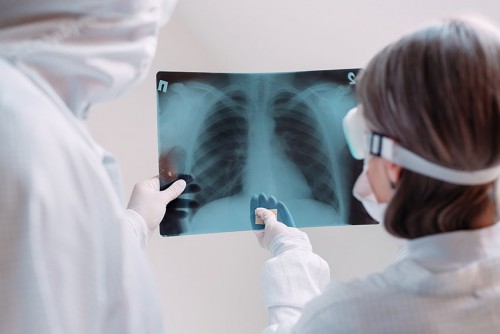A little-known bacterium — a distant cousin of the microbes that cause tuberculosis and leprosy — is emerging as a public health threat capable of causing severe lung infections among vulnerable populations, those with compromised immunity or reduced lung function.
Recent research found that various strains of the bacterium, Mycobacterium abscessus, were genetically similar, stoking fears that it was spreading from person to person.
But a new study by Harvard Medical School researchers published May 22 in PNAS, calls those findings into question, offering an alternative explanation behind the genetic similarity of clinical clusters. This suggests that the pathogen may not be that prone to person-to-person transmission after all.
“Our findings make a strong case for a different explanation behind the observed genetic similarities across strains,” said study senior author Maha Farhat, the Gilbert S. Omenn Associate Professor of Biomedical Informatics at HMS and a pulmonary disease expert at Massachusetts General Hospital. Farhat conducted the work in collaboration with Eric Rubin’s lab at the Harvard T.H. Chan School of Public Health.
The results, Farhat added, argue against direct person-to-person transmission in clinical settings and instead point to M. abscessus infections being acquired from the home or other environmental exposures.
In addition to having implications for the precautions that hospitals take to prevent outbreaks, it’s an important new clue into the behavior of a relatively unknown pathogen that poses serious risks for vulnerable populations.
The research not only contributes to the understanding of M. abscessus transmission, but also suggests scientists should be cautious about assuming human transmission when they see genetic similarities in pathogens more generally, said study first author Nicoletta Commins, who conducted the research as a doctoral candidate at HMS and is now a postdoctoral fellow at the Broad Institute.
“Our results certainly do not refute the possibility of person-to-person transmission of Mycobacterium abscessus in some cases, and more research is needed to inform best clinical practice for vulnerable patients,” she said. “However, our work supports a model in which person-to-person transmission may not be as common as it is sometimes suggested to be.”
M. abscessus is a hardy microbe highly resistant to antibiotics and can infect the lungs of immunocompromised people. While it doesn’t pose a threat to most healthy individuals, it can cause severe infection in those with suppressed immunity or people with compromised lung function such as patients with cystic fibrosis, a genetic condition marked by recurrent lung infections and lung scarring. Notably, patients with CF who become infected with this organism become ineligible for lifesaving lung transplants.
The earlier study that sounded the alarm about person-to-person transmission was based on genetic sequencing of M. abscessus samples obtained from cystic fibrosis patients at clinics in the United States, Australia, and Europe, including the United Kingdom. Researchers found few genetic mutations across the samples — a possible sign that the pathogen was spreading directly between humans.
For many pathogens such as TB, for example, recent person-to-person transmission leads to only a few or no mutations between any pair of samples simply because the pathogen does not have much time to acquire genetic mutations, Farhat explained.
“Understandably, observing the genetic similarity between M. abscessus samples caused a great deal of anxiety and fear around how these organisms could be transmitting,” she said.
Clinicians, especially in clinics that treat cystic fibrosis patients, began taking extra precautions to avert transmission. However, follow-up investigations failed to find supporting evidence that human-to-human transmission was happening, raising questions about other possible explanations for the genetic similarities across samples.
Farhat’s team set out to investigate a hypothesis that the samples appeared genetically similar because the pathogen was evolving at a very slow rate.
“We thought, yeah, you observed a small number of mutations, but we don’t know how quickly these mutations are acquired, she explained. “It may be slower than we think, and links between samples that appear recent may not be.’”
The scientists first used a large dataset of M. abscessus genomes to create a “tree of life,” a kind of genetic family tree for the bacterium.
They looked at branches of the tree with clusters of genetically similar strains, then tried to calculate their evolutionary rate. They found that these genetically similar clusters were evolving around 10 times more slowly than typical M. abscessus strains.
Next, they used computer modeling to determine whether the genetic similarities could be explained by the relatively small population size of these bacteria. But even when they simulated extreme population sizes, the result didn’t change. This was an indicator that the high genetic similarity is best explained by a slower evolutionary rate.
Finally, researchers conducted experiments to see how fast different strains of M. abscessus evolved to develop resistance when exposed to antibiotics in the lab. They found that the genetically similar strains evolved much more slowly than other strains.
“These are three separate lines of evidence supporting this idea that these clustered isolates of Mycobacterium abscessus are evolving at a slower rate,” Farhat said.
In addition to reducing concern about person-to-person transmission, the findings provide new insight into a poorly understood pathogen.
In particular, the results offer clues about how a bug found primarily in the environment adapts and changes after it enters the human body — information that could help scientists eventually understand how to prevent and treat infections.
Farhat is now planning follow-up studies that would compare bacteria in the environment with samples taken from patients, to better understand why certain patients become infected.
Source: Harvard Medical School
